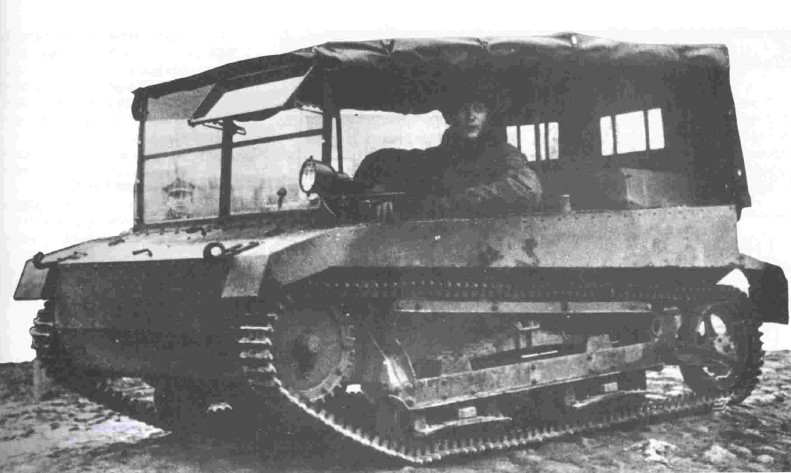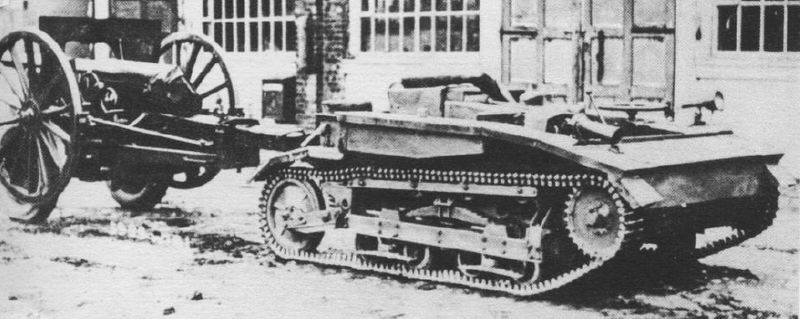C2P (1935)
 Light Tracked Tractor, c350 produced
Light Tracked Tractor, c350 produced
The C2P was a Polish light tracked artillery tractor of the interwar, based on the TKS tankette. Prime users were anti-aircraft units of the Polish Army, towing the wz. 36 anti-aircraft guns plus associated ammunition trailers but also various ordnances. However after the defeat of September, the Wehrmacht took over many vehicles, which stayed in service as the artillery-schlepper C2P(p) until 1945.

Development
In October 1931, the Polish Army General Staff wrote a proposal for an artillery tractor using at that stage the existing TK-3 tankette chassis, just adopted by the Polish Army. The idea was to simplify maintenance and makes repairs easier. The program development was under the direction of the Polish Armoured Weapons Design Office, at the Military Institute for Engineering Research. The project studies started in 1932, led by main designer engineer J. Łapuszewski assisted by A. Schmidt and engineers Lipko, Obryś and Rohn. They were supervised by Captain Rudolf Gundlach detached from the Army. The first prototype emerged from the Experimental Workshop to start its initial tests on 1 July 1933.
It was not perfect and delays to fix it led to suspend the conversion on the TK-3 and instead swap directly onto the much improved TKS tankette now just available. The prototype was designated TKS "Tygrys" tractor, before production was approved as the C2T once standardized. It was originally designed for towing field artillery regiments ordnance, and replaced the initial 12 harnessed horses and 2 horses for NCOs needed to carry around the famous French 75 mm M1897 in large numbers in the Polish inventory.
The program registered with many attempts made acros Europe to have the artillery motorized, and two tractors would do, one towing the "75" cannon, and the other towing the trailer, both having three seats each for the crew. The first tests showed that the rear was too heavily loaded. The prototype had the diameter of the tension wheels increased, unlike the original chassis, and suspended by extra coil springs as well lowered to the ground, soublingas an another pair of road wheels. New tests started on August 29, 1934.
 Prototype Towing a 75 mm field gun on a pnematic tires carrier trailer.
Prototype Towing a 75 mm field gun on a pnematic tires carrier trailer.
Still, results were unsatisfactory. New changes were introduced like a reworked steering system using side clutches. Maneuverability while towing the gun was much increased in new tests, and the prototype was given a windscreen and foldable canvas roof. The new modified prototype emerged for new tests from January 20, 1936. New trials were positive. By February 1936, the tractor made a crash course over 965 km in winter conditions towing the intended 75 mm gun, a load of 1,615 kg. More tests were carried out by June-July. By September, the tractor was then use for towing the new 40 mm wz. 36 anti-aircraft gun which was already tested. The latter was copy from Bofors. Tests were even better, and showed the tractor performed very well on dirt roads and off-road in general as intended, albeit being slow at 20 kph on average.
On February 15, 1937, the head of the Armored Weapons Technical Research Office, Lieutenant Colonel Patrick O’Brien de Lacy was very positive in his final report. He recommended the C2P would be specialized for towing the 40 mm anti-aircraft guns and secondary, for towing the 75 mm field guns and 100 mm howitzers which for the latter were just reequipped with rubber wheels. But given the feeble number of tractors delivered and heavy nature of the latter, overheating the engine, this was dropped. The C2P was also potentially used for towing the much lighter 37 mm anti-tank gun, and even having an self propelled version wth it, but again, this was never realized.
The order for the first 32 tractors at PZInż. plant in Czechowice came out by late February 1937 to equip a brand new experimental 40 mm gun division. A production line used to assmble TKS tankettes was used to begin quicker. The contract was then extended with another order for 88 and 196 tractors. By September 1939, 316 of these tractors had been built, 292 in service batteries and 117 more twere ordered for the 1939/1940 budget year, the first 40 scheduled for delivery by 30 December 1939, which the war shattered. Unit cost in 1937 was PLN 33,188 zlotys and dropped in 1940 at 30,000. In 1937–1938, two prototypes of TKS-D self-propelled Bofors anti-tank guns based on the C2P tractor were tested, but this went nowhere. Against German light tanks of the day, they could have been pretty useful.
Design
Chassis and general design
The C2P tractor was based on the TKS tankette while its hull was open, unarmoured, and 50 cm longer to circa 2850 mm. The width was about the same still at 1820 mm, and the height, with arches mounted and in the top of the tarpaulin, around 1650–1655 mm. Ground clearance was 300 mm and when fully equiupped and ready for action with the full crew of four (driver and three seats) some 2,750 kg. The tracks were also modified compared to the tankette, now with special steel cast and connected to each other by hinges using steel pins, with a width of 170 mm. Aside the driver which sat on the left, the three other members of the gun crew were seated on the right and behind on a bench. On the other side, behind the driver's seat was a rack for 3 wz. 29 carbines for the crew, and a fire extinguisher.
Mobility
 Interior, Polish Mil. tech. Museum
Interior, Polish Mil. tech. Museum
The C2P steering used side clutches to control direction, through a mechanical gearbox with 4 forward gears and 1 reverse gear. Power came from a rear-mounted FIAT 122BC (PZInż 367) 6-cylinder, 4-stroke, bottom-valve engine. It had a displacement of 2952 cm³ with carburetor. Compression ratio was 5.2:1 ahd it developed an output of 46 HP (33.9 kW) at 2600 rpm while being liquid-cooled. The fuel tank was filled with max 70 metric liters of gasoline, enough for a range of 150 km on road, 110 km on a paved road or off-road, due to a fuel consumption of 42.5 l/100 km, which rapidly rose to 70 l/100 km off-road.
The vehicle came with a 2t trailer and was still able to reach 40 km/h, down to 20 km/h off road. It had a ground pressure of 0.45 kg/cm², a turning radius was 2000 mm for a power ratio of 16.7 HP/t. Even with its trailer, the C2P could manage slopes of up to 22°, cross a ditch 1.2 m wide, and fords 50 cm of water or climb a step 32.5 cm high. The vehicle also came equipped with a searchlight with a 50 W bulb and a 15 W portable lamp, fed by an electrical system (also powering the starter) with a nominal voltage of 12 V. It was fed by a 80 Ah battery was used connected to the transmission for reload on the run.
specifications |
| Dimensions | 2850 x 1820 x 1650 mm (roof mounted) |
| Weight | 2,750 kg (with full load) |
| Crew | 1+3 |
| Propulsion | Fiat 122B Petrol 6-cyl. 46 HP/2600 rpm, 16.7 HP/t |
| Suspension | |
| Speed | 40 km/h (with full load and 2 t trailer, road) |
| Range | 70L tank, 110-150 km depending on terrain |
| Armament | None (personal weapons) |
| Protection | None |
| Production | |
The C2P in action
 C2P Tractors towing 40 mm AA guns, with another row of three vehicles behind towing the trailers.
C2P Tractors towing 40 mm AA guns, with another row of three vehicles behind towing the trailers.
C2P tractors were were distributed first to Polish anti-aircraft artillery units using the 40 mm wz. 36 anti-aircraft gun, one tractor per battery, 32 total. The 1936 Bofors licenced gun was produced friom 1936 at the Mining and Metallurgy Plant in Starachowice. Then it was decided to procure two types of 40 mm AA batteries: The type A comprised eight tractors for four 40 mm guns, the type B battery just two 40 mm guns and four C2P tractors (one for towing each gun, one for the ammunition trailer). These units were ready for combat training by the end of 1937.
The C2P had its flews, though. It was considered underpowered, whuch eliminated the 75 mm field gun and 110 mm howitzer and was to be replaced by the wheeled PZInż 343 tractor instead (future post here). The prototype of this vehicle was ready for testings in the winter 1938-1939, and won high hand versus the C2P. Noth only its roadwheels gave it much greater speeds, but a higher high towing and hauling capacity, so the ammunition trailer could be ditched and having just one tractor per gun. It was however penalized by a higher weight and poorer off-road capabilities due to its roadwheels.
The C2P were still the best performers off-road, and had a much lower silhouette, they were easier to camouflage. Ultimately the C2P tractors were kept for divisional batteries, and the new PZInż. 343 tractor for army batteries. On September 1, 1939 however only the first preèproduction batch of PZInż. 343 tractors had been produced, and it was never fielded. The C2P took part in the September Campaign, as part of 31 anti-aircraft artillery batteries Type A, 11 AA batteries Type B type for a total of 292 tractors. More were sent to the Anti-Aircraft Artillery Reserve center No. 2 in Brest and the Starachowice Works loca defence platoon.
 Under German colors, Victory Museum in Arlon, Belgium.
Under German colors, Victory Museum in Arlon, Belgium.
Many of these 300+ C2P tractors were captured by the Germans, many being renovated, put to German standard and incorporated into the Wehrmacht as Zugmittel C2P (p) or Artillerieschlepper C2P (p) and used as such on all fronts until 1945. Surviving vehicles are found at the Adam Rudnicki depot, Polish Military Technology Museum and featured in the Exhibition "War of 1939: We did what we had to do" in November 2014. One from France or Spain was located at the Victory Memorial Museum in Arlon, Belgium under German colors. It was was sent to the US's WW2 Victory Museum in Auburn, Indiana. Ppreserved in good technical condition it was later re-imported to Poland to enter Adam Rudnicki's collection as another C2P, restored to full working condition and regularly run for the public.